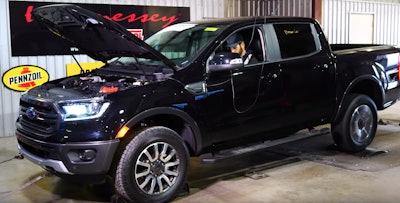
John Hennessey told Hard Working Trucks at SEMA in November that he planned on offering a VelociRaptor package for the 2019 Ranger.
“We just have to get a truck and see how much power we can get out of it,” Hennessey said as noted in the HWT video below. “I don’t know how much power we can give that little motor.”
According to Hennessey Performance’s own dyno test posted today on YouTube (see below), that little 2.3-liter EcoBoost is producing 243 horsepower and 267 lb.-ft. of torque. However, Ford lists the truck at 270 horsepower and a class-topping 310 lb.-ft. of torque.
So who’s right? Well, as far as we can tell they both are because dyno testing depends on a lot of different factors. Temperature, humidity and altitude will significantly affect power ratings. Also, different testing standards and different dynos can also result in different numbers.
“OEMs will almost always quote [SAE] J1349 corrected numbers when advertising horsepower and torque,” Ford reports in its Engine Performance Tech Tips at performanceparts.ford.com. “Some ‘tuning’ shops will report STD [SAE J607] numbers because they are always higher than [J1349]. Be sure to ask which correction factor is being used when comparing dyno numbers!”
Okay, so we did. Hennessey didn’t back to us in time, but Ford did and while they wouldn’t divulge the SAE correction factor used in testing the 2019 Ranger, they did have this to say about the differences between their test and Hennessey’s:
“We use SAE standards, but it’s important to note there’s a difference between how SAE rates engine power at the crank and how Hennessey is dyno’ing at the rear wheels,” said Dawn McKenzie, Ford’s North America communications manager for truck and commercial vehicles. “Approximately 10 percent power loss vs. published ratings is expected due to drivetrain losses.”
So, in doing the math, a ten percent power drop from Ford’s 270-hp rating takes it exactly down to Hennessey’s 243-hp rating. Torque, however, didn’t work out the same. Hennessey’s 267 lb.-ft. is a 14 percent drop from Ford’s 310 lb.-ft.
While the EPA does hold the upper hand in certifying fuel economy numbers, there is no government oversight when it comes to rating engine power. OEMs undoubtedly use SAE standards but they may or may not—as we experienced—divulge much more beyond that which matters if you’re trying to draw a comparison.
As Ford notes in its Engine Performance Tech Tips, SAE J1349 is “typically about 4% lower than SAE J607.”
For the sake of drawing fair comparisons, is there some sort of agreement between Ford and other OEMs when it comes to rating torque and horsepower?
“We can’t speak to other OEM testing methods as we can only speak to the fact that we use SAE standards,” McKenzie said.









